We plant carrots correctly and on time
Juicy crunchy carrots have not always been so appetizing. In the Middle Ages, it was purple and was only suitable for pet food. Only after Dutch breeders had worked on the vegetable did it acquire its usual orange color and pleasant sweet taste.
Growing carrots is not difficult. The culture is unpretentious and does not require special conditions. But beginners may have difficulties at the stage of preparing and sowing seeds. In the article we will talk about planting and caring for carrots in the open field, tell you when to start sowing carrots, how to prepare seed material and how to care for plantings.
The content of the article
Dates for landing in open ground
When can you plant carrots? There are two known sowing methods - podzimny and spring. Let's talk in more detail when and how to plant to plant carrots in autumn and spring.
Podzimny sowing
In autumn, sow in early, mid or late November. The specific date is determined based on weather conditions. Sowing begins when the first snow falls and the soil slightly freezes.
Important! For winter sowing, only dry seeds are used. Otherwise, they will germinate and the seedlings will die.
A garden bed for autumn planting is prepared in advance and covered with foil so that the snow does not interfere with sowing. When it comes time to plant, the film is removed, grooves are cut on the soil surface and the seeds are laid out. Sprinkle them with dry warm earth, prepared in advance. Planting is not watered.
Carrots planted in autumn will give their first harvest in June. You can then sow radish, radish, lettuce or cauliflower on the vacant bed.
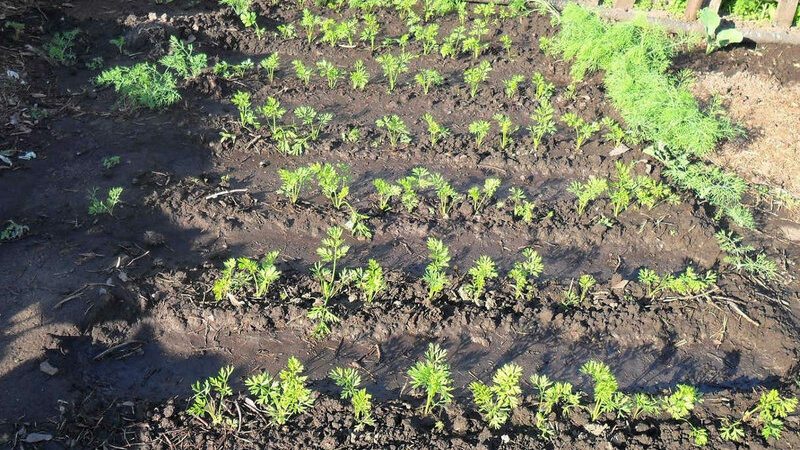
Spring sowing
When to plant carrots in spring? The sowing time is determined based on the crop variety and the growing region.
The early varieties are sown first. Sowing begins when the snow melts, but the soil is not yet very hot. In the southern regions it is March, in the Moscow region - mid-April, in the Urals and Siberia - late April-early May.
During this period, the earth is saturated with moisture, the seeds will give friendly shoots. To protect crops from frost, the beds are covered with non-woven material. For planting early varieties, the beds are prepared in the fall.
Mid-season and late varieties are sown from mid-May to early June.
Attention! With late plantings, carrots are less susceptible to invasion of pests, in particular, carrot flies.
Seeds planted in late spring and early summer no longer have enough moisture in the soil. Therefore, regular watering is required.
Each of these methods has its own advantages and disadvantages. The yield depends a lot on the weather. If the spring is early and warm, then the carrots planted before winter and in April will delight the harvest, and if it is cold and rainy, then the carrots planted in May will grow faster.
Based on this, experienced gardeners recommend combining both methods of sowing a crop.
Sowing dates according to the lunar calendar
When determining the sowing dates, they are guided by the lunar calendar.
According to him, in 2020, the following days are suitable for sowing carrots:
- in March - 10-12, 15-17, 23-25, 27-30;
- in April - 2-9, 11-15, 24-27, 29, 30;
- in May - 1-4, 12-14, 21-23;
- in June - 9-11, 18-20.
Keep in mind that it is undesirable to carry out planting work during the periods of the full moon and new moon.
Crop rotation rules
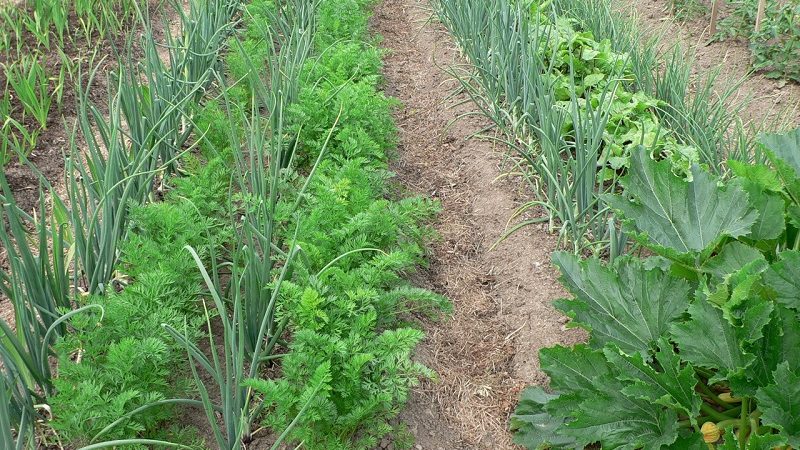
Crop rotation consists in the alternation of crops planted in the garden. This simple technique increases the fertility of the land and allows the rational use of nutrients in it. In addition, crop rotation reduces the risk of disease and pest damage to plants.
Crop rotation rules are fully applicable to the cultivation of carrots. If you do not follow them, then the roots will grow small, uneven and tasteless.
Important! The carrot bed is changed every 1-2 years. The root crop is returned to its original place only after 3-4 years.
Another reason why you should not neglect crop rotation when growing carrots is that its roots release toxins into the soil that inhibit the development of crops of the same family. Proper crop rotation neutralizes this effect.
Favorable predecessors
The most favorable predecessors for carrots are unrelated crops. Such, for example, as nightshade. It is good to plant the orange beauty after legumes, crucifers, potatoes, Luke, greenery.
Council. Plant root crops in the former cucumber beds no earlier than two years later. After cucumbers, the soil contains a lot of organic matter, which has a bad effect on the growth of carrots.
Unfavorable predecessors
Do not sow carrots after other plants from the umbrella family. First of all after parsley, celery, cilantro, parsnips.
Also, avoid garden beds where other root vegetables grew in the previous season: turnips, beets, radishes, turnips. All of them receive their nourishment from the same layer of the earth, thereby depleting it.
Landing technology
How to plant carrots correctly? Planting seeds begins with their preparation and processing.
Seed preparation and treatment
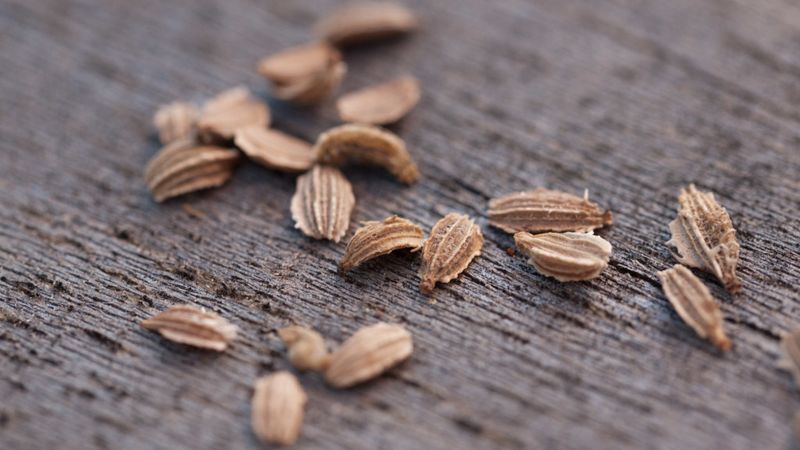
Unprepared carrot seeds germinate for a long time, up to three weeks. The fact is that the essential oils contained in them prevent swelling and the appearance of sprouts. Therefore, to accelerate germination and improve germination, the seeds are soaked.
Important! The pelleted, granulated and glazed seeds are already processed and covered with a special nutritious shell. Such granules do not require additional preparation. They are sown dry so as not to wash off the protective film.
Unprepared seeds are soaked in a gauze bag in hot water (50-60 ° C) for 20-30 minutes. This flushes out the essential oils. Then soak the cooled seeds well in a growth stimulator: "Epine" or "Zircon", in accordance with the manufacturer's instructions.
After soaking, the seeds are dried to a free-flowing state so that they do not stick to each other and to the hands during sowing.
Site selection and soil preparation
A bed for carrots is prepared in advance, in October. The place is chosen sunny and level so that rains and watering do not wash the seeds out of the soil.
In the selected area, the earth is dug up, removing weeds and insect larvae. Humus, peat, wood ash, sand are introduced. The surface is leveled and small grooves are made with a depth of 1.5-3 cm. From above, the bed is covered with boards or foil so that excess moisture does not get into the grooves.
Council. Plant garlic, onions, marigolds next to the carrot beds. These plants scare away pests with their aroma.
Carrots love loose, well-moisturized soil. It is better if the soil is neutral or slightly acidic. Acidic soils are made alkaline by adding ash or dolomite flour. Sand and peat are added to clay soil to increase its breathability.
Landing scheme and technology
Pre-soaked and dried seeds (or ready-made pelleted seeds) are sown into prepared grooves.
The seeding depth depends on the sowing method. For podzimney planting, the seeds are sealed by 3 cm.With spring planting - by 1.5-2 cm.In the row spacing, 20 cm are left.
If sowing is carried out in autumn and early spring, then watering of crops is not required. If in late spring or early summer, then the seedbed is watered with warm, settled water.
Unusual landing methods
Let's talk about several unusual ways of planting carrots:
- Dry method. The most simple and popular. Dry seeds, mixed with sand, are poured into a salt shaker and scattered along the grooves. Cons: high consumption of seeds and the need to thin out seedlings.
- Liquid way. The seeds are mixed with paste, which is poured into a teapot. The resulting mixture is poured over the grooves. Pros: the seeds are evenly distributed in the liquid, the consumption is small. Cons: labor costs for preparing the paste.
- Landing on tape... Seeds are glued to newspaper or toilet paper with paste at a distance of 5 cm from each other. Pros: the seedlings do not need to be thinned out, and the ribbons with seeds are easy to plant (spread out in grooves and sprinkle with earth). Cons: labor-intensive preparation of tapes.
- Landing in the snow... In winter, barrels are filled with snow and keep in a cold room. Before planting, a thin layer of snow is poured into the groove, carrot seeds are distributed from above and covered with earth. Pros: even seed distribution. Cons: Snow can be difficult to prepare.
Care features
Caring for carrot beds consists in timely removal of weeds, thinning crops, watering, loosening and fertilizing the soil, hilling plants.
Irrigation mode
Carrots are watered from a watering can 1-2 times a week. To moisten the earth, warm, settled water is used. From the second half of summer, watering is reduced to two times a month. 3-4 weeks before harvest, they are completely stopped.
Top dressing
If the soil has been properly prepared and fertilized before sowing, then additional fertilizing is not necessary during the growth of root crops. It is better to apply all fertilizers in the fall, during the preparation of the site for planting.
If there was no opportunity to prepare the soil, then during the growth of the plants potassium-phosphorus dressings are applied - twice in liquid form with a break of three weeks. Top dressing is stopped one month before harvest.
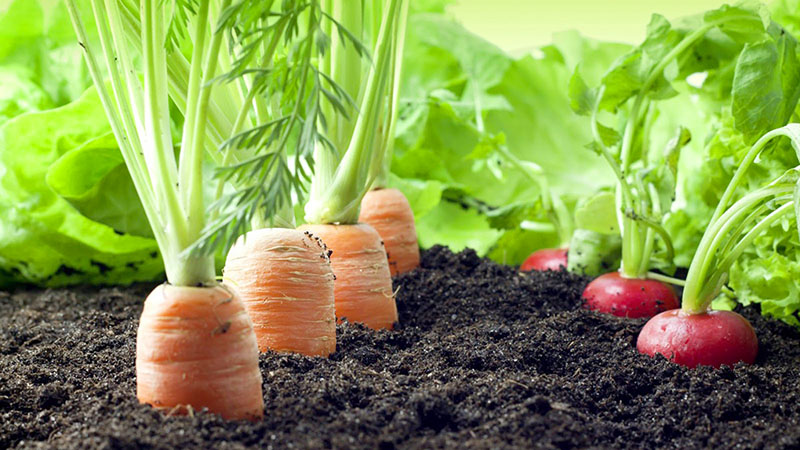
Loosening and weeding
The next day after watering or rain, the soil is loosened, providing air access to the root crops. Hilling is carried out when the tops of the root crops are exposed, covering them with earth. When the sun hits the root crop, bitterness is formed in the fruits.
Since carrots do not grow quickly, many weeds have time to grow during this time. So that they do not drown out the seedlings, the crops are weeded.
Thinning
Thinning of carrot plantings is combined with weeding and loosening of the soil. At the first thinning, a distance of 2-3 cm is left between the shoots, at the second - 5-6 cm.
Protection against diseases and pests
Carrot culture is weakly susceptible to disease... Problems can arise due to alternaria and phomosis. These are fungal diseases that cause spots on the leaves and foci of rot on root crops. Treating the beds with a 1% solution of Bordeaux liquid helps to reduce the risk of developing these diseases.
Of the parasites for carrots, the carrot fly is the most dangerous. In spring, she lays her eggs in the soil next to the emerging root crop. The larvae that emerge from the eggs gnaw through the passages in the carrots, which leads to its deterioration and decay.
To scare off carrot flies, onions, garlic, marigolds, marigolds are planted next to carrot plantings... Effectively spraying crops with an infusion of onion peels (400 g per 5 liters of hot water, leave for two days) and orange peels (1 kg of peels per 10 liters of warm water, leave for two days).
Harvesting time
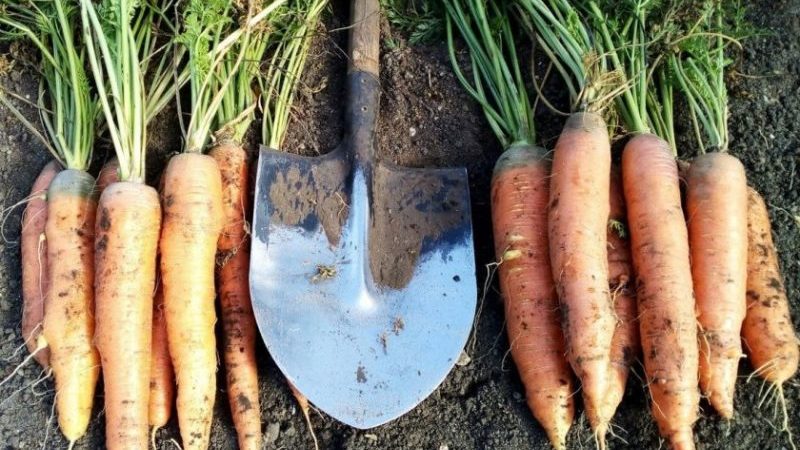
When determining the timing of harvesting, they are guided, first of all, by variety of carrots. Early ripening varieties are harvested in July. If you tighten up with harvesting, then the fruits will crack and lose their juiciness.
Attention! Early carrots are good for fresh consumption. It is not suitable for long-term storage.
Medium ripening carrots ripen in 80-110 days. Overexposing it in the ground is also not worth it, it will badly affect the taste.
Late carrots will ripen for 110 days or more.The fruits continue to grow until the air temperature drops to + 4 ° С, but there is no need to wait for night frosts. A dry sunny day is chosen for cleaning.
Carrots are gently dug in with a pitchfork and pulled out of the soil by the tops. Root crops are cleaned from the ground, greens are twisted or cut off. After that, the carrots are dried in the air for a couple of hours and stored.
Conclusion
Growing delicious juicy carrots is a simple process. To get crunchy vitamin root crops, it is important to prepare seeds (or buy already prepared ones), choose a plot for a garden, taking into account predecessors, prepare the soil and follow the rules of planting care. Then the orange beauty will reward you with a delicious and rich harvest!